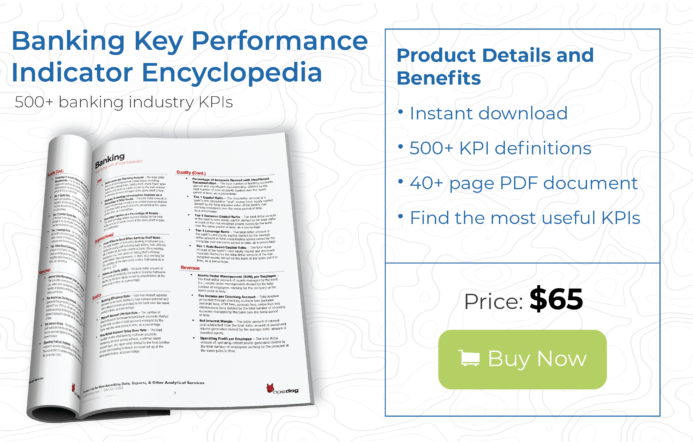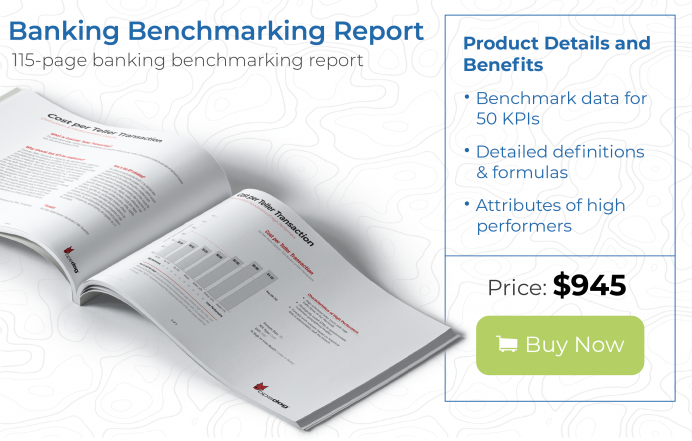As banks continue to navigate through uncertainty, more regulatory scrutiny, competition from fintech and other new entrants, and changing customer expectations, performance-based metrics have become an increasingly important part of a bank executive’s arsenal.
You may be asking yourself how to measure bank performance and you can start by measuring Key Performance Indicators (KPIs), which is the foundation of successful benchmarking practices.
What are Key Performance Indicators for Banks?
The pressure for banks to perform comes from many places: customers, shareholders, regulators, and employees. Thankfully, there are a wide variety of key performance indictors (KPIs) you can rely on. A KPI for banks can be defined as a metric that can be used to evaluate the success of a bank as a whole down to individual bank employees. From industry standard financial performance metrics such as Return on Assets (ROA) and Return on Equity (ROE) to more operationally-focused metrics such as accounts opened per employee and operating expenses as a percentage of assets, key performance indicators can help you measure bank performance.
Using KPIs, you can identify the factors that increase or shrink profits and then make strategic decisions about those factors. Over time, you can use KPIs to evaluate your bank’s success and quantify performance. For example, a KPI can reveal that closing low-performing branches will have a positive impact on profits or that you need to focus on increasing deposits to boost your efficiency ratio.
KPIs dive deeper into profitability numbers than less analytic metrics such as assets under management (AUM) so you can really understand your performance drivers. For instance, just because a bank has billions of dollars in AUM doesn’t mean they are able to effectively turn those assets into revenue. Or, those assets may include a large number of non-performing loans, driving down asset quality.
The KPIs monitored vary from bank to bank and play a crucial role in how to measure bank perfomance. A growth-focused bank will rely on different KPIs than a bank that prioritizes risk minimization. However, all banks report ROA and ROE. ROA is about efficiency: it measures how well you use your resources to generate income. ROE measures shareholder returns and is tightly aligned with how well a bank uses equity financing.
What is Bank Performance Benchmarking?
KPIs don’t exist in a vacuum. In order to improve profitability and achieve long-term success, you need to compare your bank with industry benchmarks. Use benchmarking data to make more strategic operational decisions. The goal is to improve performance and efficiency while still continuing to invest in technology, staffing, training, and marketing.
Benchmarking provides transparency to shareholders as well as bank executives. You can see how your bank stacks up to its peers and better allocate resources to hit earnings targets. Benchmarking is another tool in your box to answer the question of: How to measure bank performance?
How and Why to Use KPIs to Benchmark Bank Performance
KPIs can support a variety of bank performance goals. For example, your brick and mortar branch network may be a huge operational cost. As digital banking has taken hold, your bank likely recognizes that traditional high-cost branches can be a profitability drain. KPIs can help you re-think your physical footprint, closing branches or re-tooling their design, size, and function.
Branch-focused KPIs can help you make important decisions about your branch delivery model by identifying drains on performance such as inefficient account opening and account management, subpar branch employee training and performance, poor location, and unsuccessful marketing and advertising campaigns.
Bank Key Performance Indicators
Although some KPIs–including ROA and ROE–are standard metrics, you have a wide variety of KPIs to choose from depending on your strategy and operating model. Here are some examples.
Bank KPI Metric #1: Total Deposits Per Branch
Branches are expensive, and deposits are one way to recoup brick and mortar costs and even shore up profits. Total deposits per branch gives you a baseline of overall branch performance. Once you determine the baseline, you can analyze the performance of individual branches. You may decide to close branches with too few deposits, relocate branches to more deposit-rich areas, or improve branch employee training to increase the deposits-to-branch ratio.
To calculate, divide the total dollar amount of assets the bank manages by the number of retail branches.
Bank KPI Metric #2: Banking Efficiency Ratio
This metric compares expenses (or operating costs) to interest and non-interest income and is an easy way to measure your bank’s ability to turn assets into revenue. A lower ratio is better, with most banks striving to remain under 50%. If the efficiency ratio increases, the bank is either incurring increased operating costs or decreasing revenues.
To calculate efficiency ratio, divide non-interest expenses by total revenue (interest and non-interest income), as a percentage.
Bank KPI Metric #3: Operating Expenses as a Percentage of Assets
A large bank with billions of dollars in deposits is not automatically better managed than a smaller community bank. The ratio of expenses to assets is a better indicator of financial health. Bank assets include cash, interest-earning loans, and government securities like Treasury bills, Treasury bonds, and municipal bonds. Examples of operating expenses include employee salaries and benefits, building and occupancy costs, information technology costs, legal fees, consulting services, and directors fees.
To calculate, divide operating expenses by the total dollar amount of assets, as a percentage.
Bank KPI Metric #4: Revenue per Registered Financial Representative
Banks collect both fee and investment revenues from the sale of stocks, bonds, options, mutual funds, and annuities. Registered financial representatives are licensed by FINRA to sell securities on behalf of the bank. Representatives typically work on salary plus commission. This metric is a general gauge of bank profitability and commission fee pipeline.
To calculate, divide total fee and investment revenue by the number of registered financial representatives.
Bank KPI Metric #5: New Accounts Opened per Branch
Location, location, location. Just like in real estate, placement matters. What makes one branch more attractive to customers partly depends on the density of the market, local demand, a visible location that’s easy to get to, and other factors. Measuring the number of new accounts opened per branches is just one important way to track overall branch performance.
To calculate, divide the total number of new deposit accounts by the number of branches.
Final Thoughts
For banks, the struggle is real. Bank performance is under pressure from changing customer demands for convenient and personalized experiences, increased competition, and increasingly burdensome regulatory oversight. Learning how to measure bank performance with KPIs will allow you to measure and monitor a wide variety of financial and operational metrics that impact performance and ultimately profitability.
Interested in automating your banking back-office? Find out how to achieve successful automation here!
For a full list of banking industry benchmark ratios and other metrics, download our Banking Benchmarking Report here.
If you need more help in developing an inventory of metrics for your bank then be sure to utilize our Banking Key Performance Indicator Encyclopedia for in-depth information on over 700 KPIs, or contact us for more information on our Benchmarking Research and business intelligence implementation services. We will help you benchmark your bank and provide you with presentation-ready, high-quality deliverables at an affordable price.



